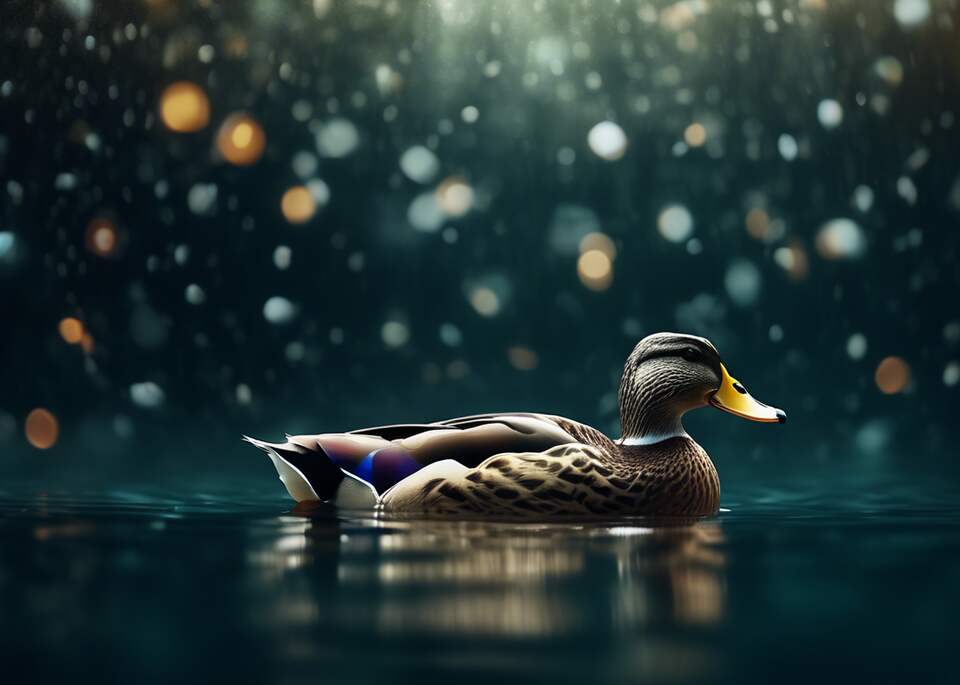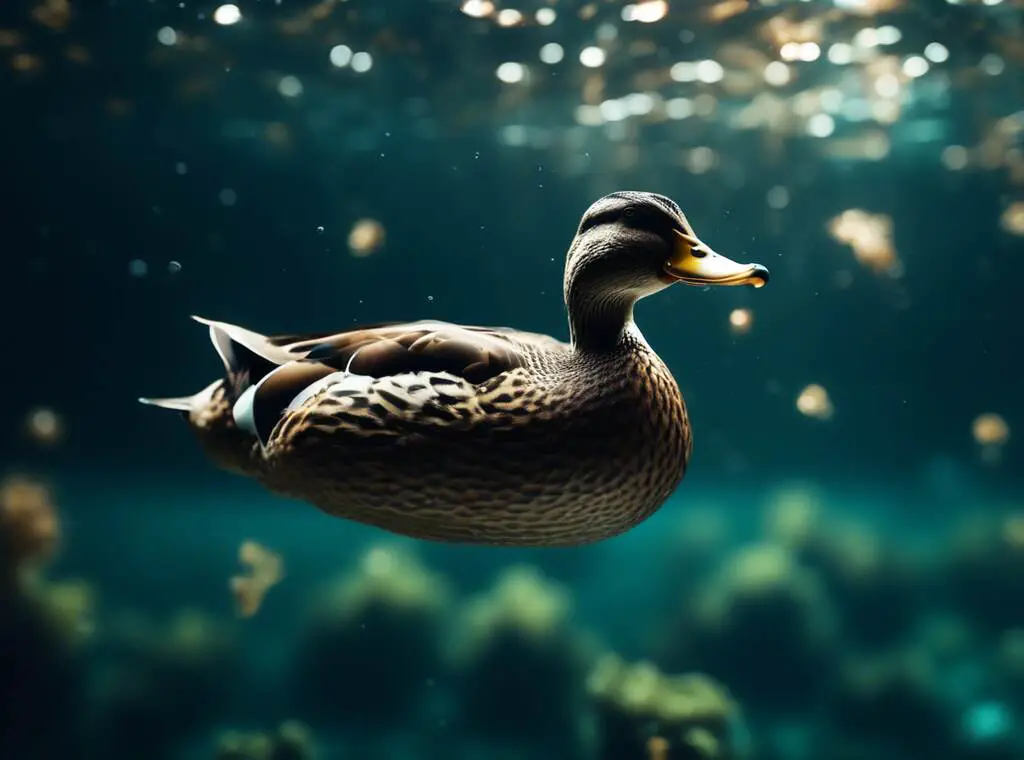Ducks are remarkable creatures known for their ability to thrive in various environments, including water. One fascinating aspect of ducks is their capability to navigate both the surface and underwater realms effortlessly. Many people wonder about the duration ducks can hold their breath underwater, considering their frequent submersion while foraging for food or evading predators.
Table of Contents
How Long Can Ducks Hold Their Breath Underwater?
Understanding Duck Behavior Underwater
Ducks are well-adapted to aquatic life, with features that enable them to swim and dive proficiently. Their waterproof feathers, webbed feet, and streamlined bodies enhance their swimming skills. When ducks submerge underwater, they rely on these physical attributes to propel themselves beneath the surface efficiently.
The Breath-Holding Ability of Ducks
Intriguingly, ducks can hold their breath underwater for varying lengths of time depending on several factors. On average, ducks can hold their breath underwater for 10 to 30 seconds. However, certain duck species have been known to remain submerged for even longer durations.
Factors Affecting Ducks’ Ability to Hold Their Breath
Several factors influence how long ducks can hold their breath underwater. One significant factor is the species of the duck. Diving ducks, such as the Common Eider, possess physiological adaptations that allow them to hold their breath for extended periods compared to dabbling ducks like Mallards.
Adaptations for Underwater Respiration
Ducks have evolved specific adaptations to facilitate underwater respiration. These adaptations include the ability to slow down their heart rate while submerged, reducing oxygen consumption. Additionally, ducks can restrict blood flow to non-essential organs, directing oxygen to critical body parts like the brain and muscles.
Behavioral Strategies for Underwater Diving
When ducks dive underwater, they exhibit unique behavioral strategies to optimize their foraging efforts. Some ducks employ a technique called “dabbling,” where they tip forward in shallow waters to reach submerged vegetation without fully submerging. This technique enables them to access food without the need for prolonged breath-holding.
Environmental Considerations
The environment plays a crucial role in determining how long ducks can hold their breath underwater. Water temperature, oxygen levels, and the availability of food sources all impact a duck’s diving capabilities. Warmer water temperatures may allow ducks to hold their breath slightly longer due to increased metabolism and oxygen availability.
Ducks possess remarkable abilities to navigate underwater environments, including the capacity to hold their breath for varying durations. While the average breath-holding time for ducks falls between 10 to 30 seconds, this can differ based on the duck species, environmental conditions, and diving techniques employed. Studying ducks’ behavior underwater offers valuable insights into their adaptations for survival in diverse habitats.

The Adaptations of Aquatic Birds for Underwater Foraging
Aquatic birds have evolved remarkable adaptations to thrive in underwater environments, allowing them to forage for food efficiently. One such group of aquatic birds is ducks, known for their ability to swim and dive gracefully in search of aquatic prey. A common question that arises regarding ducks is, “How long can ducks hold their breath underwater?” Understanding the unique features that enable ducks to stay submerged is fascinating and provides insight into their underwater hunting techniques.
The Physiology of Ducks
Ducks possess specialized physiological characteristics that enable them to stay submerged for extended periods. Their bodies are adapted to reduce drag while swimming and diving, allowing them to move effortlessly through the water. One key adaptation is their waterproof plumage, which traps air close to their bodies, providing insulation and buoyancy. This feature not only helps them stay afloat but also minimizes heat loss in cold water environments.
Buoyancy Control
Buoyancy plays a crucial role in a duck’s ability to stay underwater. By adjusting the air trapped in their plumage and body cavities, ducks can control their buoyancy levels. This allows them to dive underwater with precision, either by slowly submerging or quickly descending to varying depths. The ability to regulate buoyancy helps ducks reach submerged food sources while conserving energy during underwater foraging.
Underwater Foraging Techniques
Ducks employ a variety of techniques to forage for food underwater effectively. They may perform shallow dives to reach plants, algae, or small invertebrates near the water’s surface. In contrast, certain duck species are capable of deep dives to capture fish and larger aquatic prey. These dives can last anywhere from a few seconds to a few minutes, depending on the duck species and the availability of food.
Breath-Holding Abilities
When it comes to breath-holding capabilities, ducks exhibit impressive skills that vary among species. On average, ducks can hold their breath underwater for 10-20 seconds during shallow dives. However, some species, such as the diving ducks, have been recorded holding their breath for up to 30-40 seconds or even longer during deeper dives. These diving ducks have evolved larger lungs and more efficient oxygen utilization to support their extended underwater excursions.
Adaptations for Underwater Vision
In addition to their breath-holding abilities, ducks have adapted their vision to locate and capture prey underwater accurately. Transparent eyelids called “nictitating membranes” act as goggles, protecting their eyes while maintaining visibility beneath the water’s surface. This adaptation allows ducks to spot prey, navigate obstacles, and avoid predators while submerged, enhancing their hunting success in aquatic environments.
The adaptations of ducks for underwater foraging highlight their remarkable evolutionary journey in conquering aquatic habitats. Through specialized physiological features, buoyancy control, efficient breath-holding abilities, and underwater vision adaptations, ducks have mastered the art of hunting beneath the surface. The next time you observe a duck gracefully gliding across a pond, remember the hidden world of skill and agility that lies beneath the water’s surface, where these avian divers showcase their exceptional adaptations for survival and sustenance.
Conclusion
In the realm of underwater foraging, ducks and other aquatic birds showcase remarkable adaptations that enable them to explore aquatic environments with ease. Their ability to hold their breath while diving plays a crucial role in this process. Ducks can hold their breath underwater for varying lengths of time, depending on the species and their specific physiological adaptations. For some species, this duration can be as short as 10-20 seconds, while others, like the common eider, can stay submerged for up to 2 minutes. These capabilities are made possible by a combination of physiological adaptations and behavioral strategies that help ducks thrive in aquatic habitats.
The adaptations of aquatic birds for underwater foraging are truly fascinating. From specialized respiratory systems to streamlined bodies, these birds have evolved numerous features that facilitate their diving and foraging activities. One key adaptation is the ability to reduce the oxygen consumption of vital organs during dives, allowing ducks to extend their time underwater. Additionally, their plumage is designed to trap air and create a layer of insulation, preventing heat loss and aiding in buoyancy control.
Furthermore, the unique anatomy of aquatic birds includes adaptations such as webbed feet for efficient propulsion through water, waterproof feathers that maintain buoyancy and insulation, and specialized beaks and eyes for capturing prey underwater. By combining these physical adaptations with behavioral techniques like diving and preening, ducks can effectively navigate underwater environments and secure their next meal.
Understanding how long ducks can hold their breath underwater sheds light on the remarkable adaptations that enable them to thrive in aquatic ecosystems. By exploring the intricate balance of physiological, morphological, and behavioral factors that contribute to their diving capabilities, we gain a deeper appreciation for the complexity of nature’s designs. Ducks serve as ambassadors of adaptability, showcasing nature’s endless capacity for innovation and survival in diverse environments.
As we marvel at the grace and efficiency with which ducks move through the water, we are reminded of the interconnectedness of all living beings in the natural world. The adaptations that allow ducks to hold their breath underwater represent a delicate equilibrium that has evolved over millennia, reflecting the intricate dance between form and function in the web of life. By studying and appreciating these adaptations, we not only gain insights into the fascinating world of aquatic birds but also deepen our understanding of the broader principles that govern biological diversity and ecological resilience.
The next time you observe a duck gracefully gliding across a pond or diving beneath the surface in search of food, take a moment to appreciate the incredible adaptations that make such behavior possible. From their breath-holding abilities to their specialized anatomical features, ducks exemplify the beauty and complexity of nature’s evolutionary tapestry. By delving into the secrets of how long ducks can hold their breath underwater, we unveil a world of wonders that invites us to marvel at the ingenuity of life itself.



